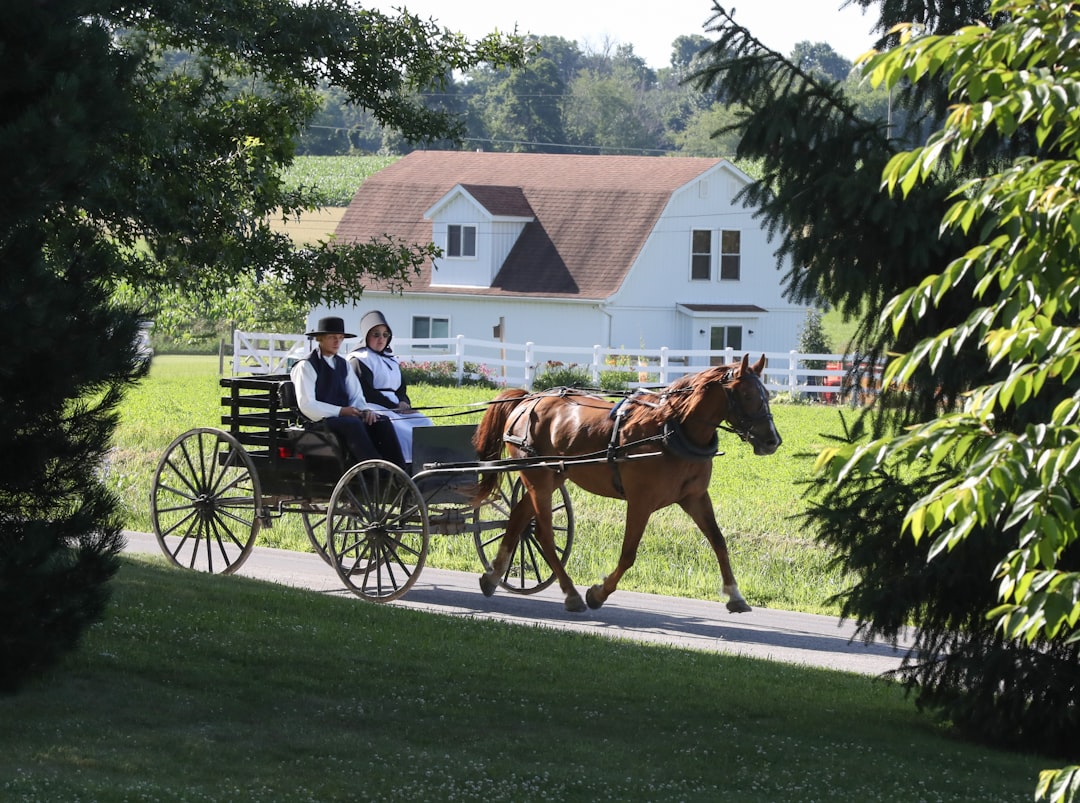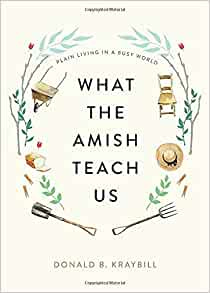Good morning everyone and welcome back to the Quarantine Creatives newsletter, a weekly companion to my podcast of the same name.
This newsletter is free and delivered to inboxes on Sunday mornings, so if you like what you’re reading, please consider subscribing!
In today’s issue, I consider whether our relationship to technology like cars and social media is good, bad, or somewhere in the middle, with some inspiration from the Amish.
Negotiating Modernity
The first Weird Al Yankovic song that I remember hearing was Amish Paradise. It blew my mind that somebody had taken the rhythm of Coolio’s Gangsta’s Paradise and made it into a hilarious spoof of Amish culture. I immediately bought his album Bad Hair Day and then dove into his other records.
But as amazing as I found Weird Al, what really spoke to me in that first listen was his descriptions of Amish life, even in the context of parody.
If you come to visit, you'll be bored to tears,
We haven't even paid the phone bill in 300 years.
But we ain't really quaint, so please don't point and stare,
We're just technologically impaired.
I grew up half an hour from an Amish settlement in Middlefield, Ohio. We would visit there on weekends, passing horse-drawn buggies on the country roads and patronizing Amish businesses (shout out to Mary Yoder’s Amish Kitchen).
Still, the Amish remained a curiosity to me, a culture who seemingly hit the snooze button on history sometime in the late 1800s. My impression was that they picked an arbitrary date and decided that anything invented after that was sinful.
I had it all wrong.
In last week’s newsletter, I mentioned that I recently read What the Amish Teach Us by Amish scholar Donald Kraybill. I highly recommend it!
Kraybill’s book describes how without a central governing body, each local Amish community is in their own negotiation with modernity, where some aspects of modern life are accepted, others are rejected, but many are bargained with, seeking to integrate the benefits without the inherent downsides.
They're not willing to accept whatever modernity brings their way. Their eye is on long term planning- on the downstream consequences that technology might have on their community and its future.
It reminds me a bit of the Seven Generation Principle of the Haudenosaunee people. You’ve probably seen it reduced to a slogan on cleaning products, but the core idea is that we should consider the impact of our decisions on the future seven generations. The Amish, like the Haudenosaunee, aren’t thinking short term.

For outsiders, Amish negotiation is perhaps most obvious in their approach to cars for more than 100 years. Again from Kraybill:
As the cars rolled off Detroit's assembly lines, the Amish kept driving their horse-drawn carriages. Localism- supported by a horse culture that tethers members close to home- has always ruled supreme in their society. Horse conveyance supports a face-to-face, small-scale, oral community and keeps Amish people out of cities.
But the Amish, do not fully shun cars. In most communities, there is an acceptance that cars have benefits as well, such as providing access to medical care or work opportunities for contractors.
This is where the negotiation and bargaining come into play. The Amish are forbidden from owning cars, which would provide freedom of movement at will, but they are permitted to hire cars from non-Amish neighbors when needed. Access, but not ownership. A mediated relationship. Donald Kraybill:
Every buggy that plods along a modern highway proclaims PATIENCE. "The horse is our pacer," explained an Amish man. "We can't speed up like you can in a car. Our horses set the pace for life and slow things down. Riders in an open-window, gadget-free buggy can see and smell the countryside and nod to friends along the way.

I like this general notion of mediation, even if I think the Amish end up with confusing logic to justify certain technological needs. It reminds of something I read in Addison Del Mastro’s daily newsletter The Deleted Scenes about how our own relationship to the car has changed:
Maybe we got it right the first time, a century or more ago: cars are great for leisure and exploration and sport, but not so great for commuting, running errands, and other everyday tasks, at least in areas that were already substantially built out before widespread car ownership. It was once common, for example, to own a car for weekend drives, but commute on the trolley.
But we were sold—and to our discredit, we bought—gridlock and rush hour and ten-minute trips for a half-gallon of milk and 30,000 Americans violently killed each year under the banner of exploration, freedom, and the open road.
I grew up in a neighborhood of 1920s era houses, built at a time when car ownership was just starting to become more accessible, but places were still built with humans in mind.
Homes had large front porches that overlooked the tree-lined sidewalks of our suburban street. Anytime we went out for walks or to play in the front yard, we were inevitability greeted by waves from neighbors. Of course everyone owned a car by my childhood, but there were plenty of places to which we could walk, and lots of safe, wide sidewalks for those pedestrians.
While my experience was suburban, urban people have similar experiences. A stoop may replace the front porch, but the idea of walkable sidewalks and a sense of community is present in many of our environments built prior to the mid-twentieth century.
I live in a very different neighborhood now. It still has sidewalks, but on a busier road that feeds right into a highway and has a high speed limit. It’s car-oriented, not people-oriented. I know my neighbors more by the cars they drive than their faces, even after living in the same house for almost 14 years.
We have built our neighborhoods, roadways, and businesses almost exclusively for the car since the end of World War II. I wonder if the Amish idea of negotiation with cars, rather than outright submission, would have been a more sustainable approach, and what our neighborhoods would look like had we bargained more.
Negotiating Social Media

Beyond the car, I have also been wrestling with another technology that could use some Amish-style negotiation in our modern world: social media.
Many of us are aware of the addictive nature of social media. The feed is never ending, encouraging doom scrolling. The dopamine hit of likes and mentions can be intoxicating. There’s an urge to speak out, even with nothing to say.
We tend to follow and interact with accounts that validate our own biases, opinions, and preferences. It’s easy to get stuck in an echo chamber, and even easier to characature or even vilify those whose beliefs differ from our own.
But in the real world when you are in close physical proximity to those with different political, religious, or cultural beliefs and must interact with them daily, you are forced to confront those differences and get along.
It reminds me of a conversation that I had on the podcast with Erin and Ben Napier, who star in the HGTV series Home Town. We spoke in June, 2020 soon after the killing of George Floyd. At the time, many people were posting black squares on Instagram in support of Black Lives Matter, but Erin and Ben did not follow that trend.
A short time later, Erin posted a DM exchange that she had with a Black fan about her perceived silence on the matter.
You can click the image above to scroll through the full post on Instagram, but the most relevant section includes this from Erin:
“I want you to know that my social media quiet is not a difference of opinion, it's just a difference of expression. I think taking a "bigger" stand lies in the small opportunities we meet every day as we go to the post office or order food in a restaurant. I live in a 60% African-American city. I go to church with people who are not my color. I've loved those people and worshipped with them and I’ll teach Helen [their daughter] the same.”
Erin, Ben, and I discussed this approach in more depth on the podcast. Here’s what Erin had to say:
“The way we can best serve the world and our community is by doing things like helping African-Americans find a path to homeownership, by partnering with other African-American families to do it, rather than posting something to social media that just is forgotten in two weeks. It just is noise. It’s not doing.”
It is true that even the best intentioned posts can be misinterpreted on social media. It’s much harder to misjudge actions that are happening right in front of you, or to misunderstand a face-to-face conversation. And I really appreciate Erin’s approach that favors real action over performative posting.
All of this might lead one to conclude that we are better off without any social media. Erin and Ben are temporarily experimenting with the idea, tweeting this just a few days ago:

But social media isn’t all bad. If we’re open to it, we can hear alternate points of view and the lived experience of those different than us, increasing empathy.
It can also connect people that have similar interests or hobbies but live on different continents. Why deny somebody that connection simply because of geographic constraints?
I’m trying to take a more Amish approach to social media lately- mediating my access to it, selecting when it can benefit me, and limiting it when it can be harmful.
That has meant deleting social media apps from my phone, but accessing them through the web browser or using a laptop. Like the Amish rules around cars, I still can enjoy the benefits of social media, but without such immediate access that clicking on an app might give me. It’s a start.
I’m not sure that the Amish solution is entirely the right one, but I do think there’s a morsel of truth in thoughtful consideration on the downstream effects and deliberate moderation.
Your Turn!
I have not done a great job cultivating the comments section of this newsletter. I often hear from people directly by email, but I’m hoping to build this into more of a community where we can all share our ideas and connect.
How do you feel about your relationship with cars and/or social media? Have you had success in mediating your relationship with either one? Or am I being too romantic and idealistic thinking that’s possible? Leave a comment- I’d love to hear your thoughts, as I’m sure would other readers!
What’s Next
Next week, a new episode of the podcast will return, with an interview with Dr. Steven Gundry. He’s a former cardiac surgeon who has shifted the focus of his practice over the last 20 years from treating heart disease to preventing chronic diseases through diet.
His best-selling book The Plant Paradox changed my family’s life. Dr. Gundry has a new book, and he’ll be joining me to discuss his latest findings in how the food we eat is making us sicker than we know, and how some tweaks to our diet can make us healthier, feel more energized, and live longer.
Please subscribe to the show in your favorite podcast app to hear the interview on Thursday!
I have exciting news to share: You can now read Quarantine Creatives Newsletter, along with lots of other amazing newsletters in the new Substack app for iPhone.
With the app, you’ll have a dedicated Inbox for my Substack and any others you subscribe to. New posts will never get lost in your email filters, or stuck in spam. Longer posts will never cut-off by your email app. Comments and rich media will all work seamlessly. Overall, it’s a big upgrade to the reading experience.
The Substack app is currently available for iOS. If you don’t have an Apple device, you can join the Android waitlist here.
If you have questions, comments, thoughts, ideas, or anything else that you’d like to share, please feel free to email me anytime.
If you’d like to catch up on past episodes of the Quarantine Creatives podcast, they can be found on Apple Podcasts, Spotify, or wherever you listen.
Please consider sharing this with a friend that you think might enjoy reading this, or better yet, share it on social media so you can tell hundreds of friends!
If you’ve missed past issues of this newsletter, they are available to read here.
Stay Safe!
Heath










Heath, I am also interested in a simpler life. I hate being chained to a car. They are expensive machines that require a lot of care. I would prefer to take a trolley or train to a number of locations and at one time, those existed. We got rid of many things in the name of progress, but those things are making a comeback if people will look around. We need to know each other for this world to get better.